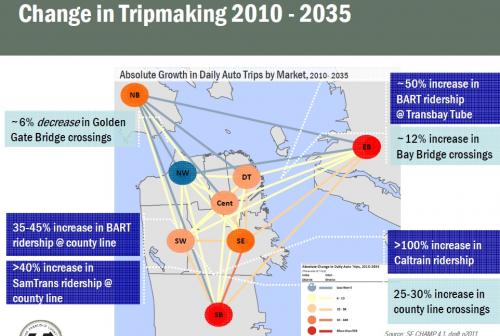The San Francisco County Transportation Authority is working on an update to the city’s Long Range Transportation Plan. As part of the update, the authority has been conducting analysis of transportation patterns in the city, and looking at projected growth, and its implications. Some of the results have already been released (pdf), and the findings should provide advocates and governments in the Bay Area some food for thought:
1. The growth in traffic across the city’s southern border isn’t going to stop. The region is expecting some improvement in the jobs-housing balance in the South Bay, but it won’t be enough to stop increases in trips across the SF-San Mateo boundary. This makes the search for steady funding for Caltrain even more urgent, and also raises the question of whether we need to think about road pricing on I-280 and US-101.

2. San Francisco will need to address transit time to stay competitive. Transit investments in the region have been flowing disproportionately to the suburbs, and as a result, the cost (in time and money) of traveling via transit is expected to decline throughout the Bay Area – except here in SF. Here in the city, we will face slower buses on congested streets, as well as commute patterns that don’t just flow to our transit-rich downtown, but areas like Hunter’s Point and Mission Bay that are much less well served. Effectively serving these emerging job centers will require new infrastructure; otherwise, we will see even more commuters turning to auto transportation.

3. Transit funding needs to better reflect where the transit riders live and work. San Francisco is home to 11% of the region’s people, and 16% of its jobs, but 69% of its transit trip ends. But since funding tends to follow population figures, the city simply does not get its fair share of investment, with money flowing to suburban extensions instead of increases in core capacity. Changing this will be a massive challenge politically, but it is essential if we are to continue having a healthy center city.

4. Better land use is going to be an essential part of fighting climate change. The SFCTA looked at several strategies for reducing carbon emissions through transportation policy, and the short version of the story is that they don’t get us anywhere near the goals we’ve set. Questions of improving land use – getting rid of surface parking, densifying transit-rich neighborhoods, and bringing office space back into the core – are out of scope for the SFCTA, but for the city at large, it’s a huge part of the solution.

The SFCTA is continuing its work on the long-range plan, and holds meetings (open to the public) with a Citizen’s Advisory Committee on the topic every quarter. Keep posted on the agency’s work at movesmartsf.com.